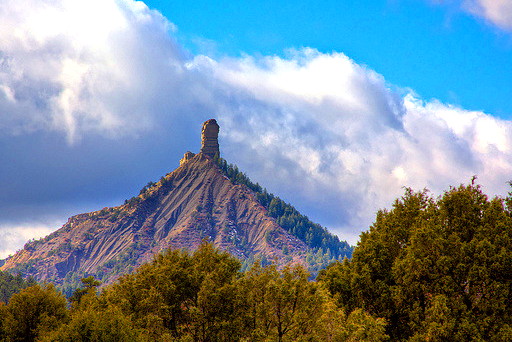
When President Barack Obama designated the new Chimney Rock National Monument (Monument) September 21, he affirmed the area’s centuries-old cultures that are maintained by today’s tribal descendants. The designation also carries the potential for increased tourism in the area.
As the president’s official proclamation was signed in Washington, D.C., a community celebration was held at the southwestern Colorado Chimney Rock site just before the autumnal equinox, with aspen trees turning gold in the surrounding San Juan mountains and a strong hint of fall in the air.
“The Chimney Rock site in southwestern Colorado incorporates spiritual, historic, and scientific resources of great value and significance.” the president’s proclamation states. “A thousand years ago, the vast Chaco civilization was drawn to the site’s soaring massive rock pinnacles, Chimney Rock and Companion Rock, that rise hundreds of feet from the valley floor to an elevation of 7,600 feet. High atop ancient sandstone formations, Ancestral Pueblo People built exquisite stone buildings, including the highest ceremonial “great house” in the southwest.”
Chimney Rock, between Pagosa Springs and Ignacio, headquarters of the Southern Ute Indian Tribe, will be maintained by the U.S. Forest Service and the nonprofit Chimney Rock Interpretive Association. It should be noted that it was White House involvement that finally pushed this key proclamation forward, steering the likes of the U.S. Department of Agriculture and the Forest Service towards this crucial step. The two aforementioned departments have a final sacred places report that hasn’t moved off their desks since last year.
Key officials at the celebration were Ken Salazar, Secretary, U.S. Department of the Interior; Tom Vilsack, Secretary, U.S. Department of Agriculture; Chandler Sanchez, chairman of the All Indian Pueblo Council, which represents 20 pueblos in the Southwest; and other representatives, including those from the Southern Ute, Ute Mountain Ute, Hopi, Navajo, and Jicarilla Apache tribal nations.
Also invited were Rep. Scott Tipton (R-Colorado) and Sen. Michael Bennet (D-Colorado), both legislators who, among others, worked for more than two years to obtain the designation.
The 4,726-acre area included in the Monument is in the San Juan National Forest, where the dual towers of Chimney Rock are attributed to the Chacoan culture. The culture arose in the mid-800s and continued about 300 years in the Four Corners area where Colorado, New Mexico, Arizona and Utah meet today.
A lunar viewing point at Chimney Rock is associated with that culture, which aligned structures in part to lunar, solar and cardinal directions. Every 18.6 years the moon rises and sets between the ancient twin towers in what is termed the Northern Lunar Standstill.
The ancestors of modern Pueblo Indians occupied the area, described by descendants as part of a wider hub where individuals and clans converged to share ceremonies and traditions, according to material from the Chaco Culture National Historical Park in northern New Mexico.
The Monument, a sacred place to Chacoan descendants, also is important to modern Coloradans for a different reason: “Tourism is an important driver of Colorado’s economy,” Al White, Colorado director of tourism, is quoted in a Forest Service release. “Protecting places like Chimney Rock protects this economic engine and ensures our outdoor industry can continue to grow.”